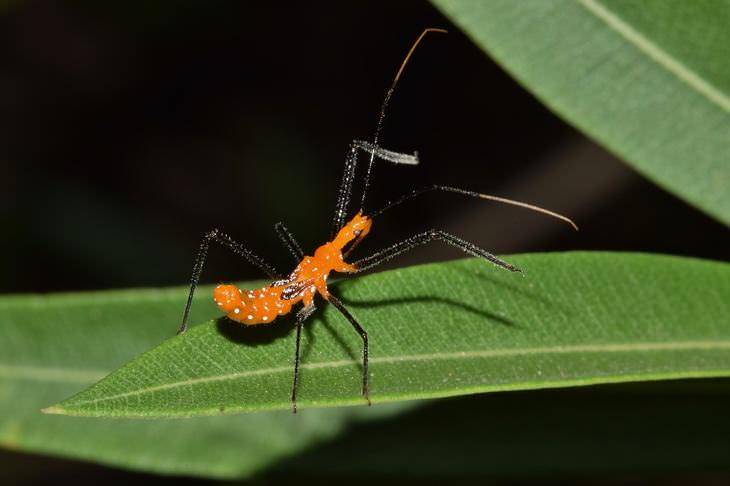1. Assassin Bug
While they may appear to be the creepiest looking insects, their speed, aggression and appetite make them a favorite. These bugs eat just about anything including ants, aphids, bedbugs, chinchbugs, leafhoppers, termites and more. To attract these bugs consider planting smaller flowers, that are easier to reach into, like Queen Anne's Lace, daisy varieties, oleander, fennel, alfaalfa, camphorweed, goldenrod, and dill.
2. Beneficial Nematodes
These microscopic, worm-like organisms will keep all pests at bay. They will target the bad bugs, however, they occasionally go after the beneficial insects too - so watch out! Nevertheless, these bugs prefer ants, beetles, borers, caterpillars, fleas, insect larvae, including moths and fleas. They also like maggots, webworms, weevils, and wireworms. Attracting these bugs can be difficult. You'll most likely have to purchase your first round, introducing them to your garden and keeping them there by using plenty of compost, mulch and biodiversity.
3. Ladybugs
These bugs are a favorite in the garden, and most certainly, the most well-known. Despite their popularity, these bugs may not be the best. They are slow to reproduce and will only lay large numbers of eggs when there is enough prey to support them. While they consume a large amount of pests, they are more vulnerable to their predators - the ants. They most commonly eat aphids, mealybugs, mites, and pest eggs. Plants that attract the ladybug include basket of gold, buckwheat, butterfly weed, carpet bugleweed, cinquefoil, coriander, dandelion, dill, fennel, four-winged saltbush and yarrow, among others.
4. Big-Eyed Bug
Big eyed bugs tend to live longer than most other beneficial bugs and lay eggs most of their lives, averaging about two or more every single day. They also tolerate imbalanced conditions, search soil and plant surfaces for prey and have voracious appetites. When prey is scarce, they will opt for nectar and honeydew. A large part of their diet consists of aphids and their eggs, bollworms, cabbage loppers, caterpillars, lacewings and their eggs, mites and their eggs, weevils and whiteflies.
5. Damsel Bug

These bugs have a similar appetite to the mantis. They will eat any insect smaller than them, including beneficial garden insects, and if they can't find anything else, they will eat one another. Common prey includes aphids, caterpillar and their eggs, fleahoppers, small larve of various insects, spider mites and treehoppers. These bugs are attracted to caraway, cosmos, fennel, spearmint, goldenrod and marigold.
6. Minute Pirate Bug
These predatory beneficial garden bugs will eat pollen and plant juices when prey is not available. Though generally they will feed on aphids, caterpillars, corn borers, corn earworm eggs, insect eggs, spider mites and thrips. Keep alfalfa, caraway, cosmos, fennel, marigold and spearmint to attract these bugs.
7. Fly Parasites
Fly parasites do not bother adults, children or animals, they target flies and lay their eggs inside the pest. Once hatched, the fly parasite consumes the insect, making them a creepy, yet beneficial insect. It's diet is limited to flies. To attract these bugs, include buckwheat, golden marguerite, lemon balm, parsley and thyme.
8. Soldier Beetle
Both the larvae and adults of this prey are predatory. They usually prey on aphids, beetle larvae, caterpillars, grasshopper eggs and insect eggs.
9. Praying Mantis
The praying mantis has a longer life cycle than most other beneficial garden insects. While this may be of benefit to your garden, one of its drawbacks is that they won't deposit their eggs until they are five to six months old. Furthermore, it can be difficult to keep them around. The praying mantis feeds on most insects, including the beneficial ones and even its own kind. They will also feed on small invertabrates such as small frogs, lizards, mice and hummingbirds.
10. Spiders
Spiders are often viewed as bad insects in the garden. But most are beneficial in eating insects and rarely bite humans. Be wary, however, of the brown recluse and black widow spider. Some spiders will only eat insects trapped in their web, such as jumping spiders and wolf spiders. They commonly eat ants, beatles, flies, grasshoppers, stick bugs and more. So long as the environment isn't sterile and pesticides aren't being used, you won't need to do much to attract spiders to your garden. Beware, though, of wood piles and other dark hiding places that can harbor black widows.





